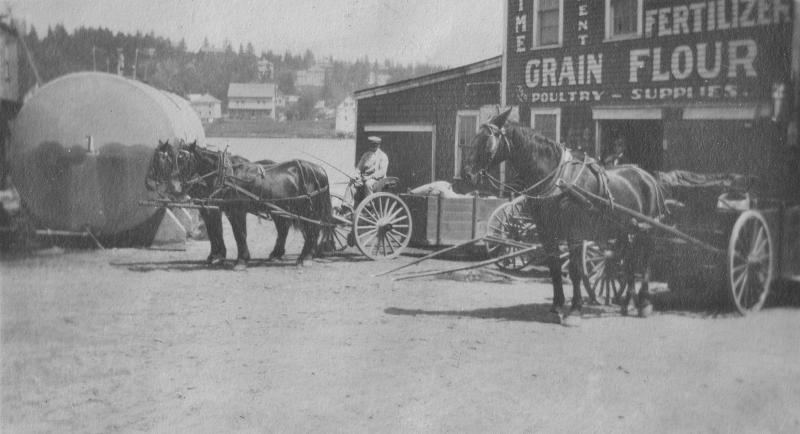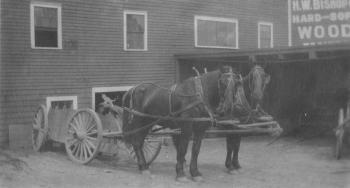Bishop's Grain Mill in the 1910s

The Boothbay Region Historical Society is raffling an Earle Barlow print, described elsewhere in this issue. The print harkens back to another time, 1910s in Boothbay Harbor when the old patterns and ways of a self-sustaining, subsistence life still held in the region for almost everyone. Motorized transport was a rare novelty; there was some electricity but it was very limited, as was plumbing. Goods and passenger were still carried mostly by vessel.
As a rule, the majority of people here still lived agrarian, rural lives, with a woodlot for heat, a vegetable garden, and a small amount of livestock, maybe a cow, a pig, and some chickens. They did for themselves, but worked part of the year for cash to buy those necessities they couldn't create. Some businesses devoted themselves to some basics of life, specialized hardware stores.
Earlier history
Such was the H. W. Bishop business on the site of The Chowder House between 1909 and 1915. To briefly cover its earlier purposes, the spot had been a fishhouse and smokehouse lot before the 1820s, then in 1850 it became the shipyard of Stephen Sargent, who turned out brigs, barks, schooners, and a ship. In the mid-1860s Arber Marson took it over as a little repair yard, which he sold in the mid-1870s to Manson McKown who, in turn, built pleasure boats for summer people, a relatively new market. With a small sawmill and machine shop, he had a good setup. He also sold coal, perhaps for small steamboats and for those who'd switched from wood heat in their homes; and he allowed room for a junk and paper business upstairs in the 1880s. Sadly, some valuable 1700s town records were among the papers that went for junk.
Bishop's Basics
In 1909 Manson McKown sold to Harold W. Bishop who had an easy commute — living next to the east end of the footbridge, he walked across and turned north a few hundred feet along the waterfront. Bishop discontinued the 60 years of vessel focus in favor of selling raw materials. He augmented the coal with hay, grain, flour, cement, lime, plaster, water pipe, seeds, fertilizers, farming implements, oil, gasoline, and poultry supplies. A 1911 letterhead shows the grain products were corn, meal, oats, wheat, mixed feed bran, cottonseed meal, and gluten. Some oddities on the letterhead are oyster shells (plaster and chicken feed?), beef scraps, hair (for plaster?), and salt. The products clearly indicate that the local need for livestock fodder was still sizeable.
In 1915 Bishop sold out to his employees B. E. Hume and Flora Hodgdon who continued in the same vein, adding also prized sharp sand from Merrymeeting Bay for masons, Berkshire or White Chester pigs, harnesses, and incubators. In 1927 Hume sold out to Marson Brothers.
In Florence Haggett's time working for Marson in the 1930s, horses were finally discontinued in favor of trucks for deliveries. Similarly, the sale of feed to power horses and livestock diminished as the sale of products to power engines, such as oil, bottled gas, and coal, increased.
Acquiring and distributing
The Barlow print depicts the business from the water in Bishop's years, including the long wharf associated with it. We have many photos of the business since the building and wharf were so picturesque, with the 62-foot schooner, C. M. Gilmore, usually laying alongside the wharf. The schooner, built in 1876 at St. George and owned by Bishop, brought bulk products from Portland and Rockland until it was replaced in Hume's time by the 54-foot schooner Railroad as the business's delivery means. The Railroad, built in 1872 in Castine, lasted in its role until 1933.
Whatever business was on that site was responsible for opening the swing section of the footbridge when necessary for vessels like the Gilmore or Railroad to get through. It operated like the old Southport bridge or the current Barters Island bridge, with a bar inserted by a man who walked it around, like a clock hand driving cogs instead of vice versa. Even into the 1970s, the bar stood in a corner of Anderson & Gaw's plumbing and heating business when it was on the site.
Once the materials were unloaded from the schooners and on hand at Bishop or Hume or Marson (the next owner up to 1941 when Anderson & Gaw took over), they had to be parcelled out to customers. Deliveries were by horse-power and the two photos with this article show the horses and carts. Perhaps the teams and the back (street) side of the building are not as picturesque as the water side, but they show the nut and bolts of getting the products out the door to the customers in a slower age.






























